My second World Heritage Site visit in Uganda, the final such experience of the bizarre year that was 2020, was one that corrected a major error that I made long ago. During the African Stage of the Tour of Gondwana, fifteen years earlier, I made a spontaneous change to my route, a decidedly uncharacteristic behavior for me. I had intended to ride due south through Kenya and Tanzania, and then continue on towards Cape Town. Along the way, however, I decided to divert slightly to the west so that I could see the small countries of Rwanda and Burundi. In so doing, one day I found myself in the small town of Ruhengeri, Rwanda, which happens to be that country’s base of operations for treks to observe the endangered Mountain Gorilla. Of course, that would be an experience that I would normally sign up for in a heartbeat, but on that occasion I talked myself out of going, primarily for three reasons. The next trip was scheduled to begin at six the following morning and, with the more strenuous pace I kept on that previous Tour, I most certainly wanted to sleep late that day. Additionally, my left wrist was still sprained, swollen as if I was wearing a mitten, after a child-caused fall a couple of weeks earlier, and its right-side counterpart was equally puffy after receiving multiple stings during a recent attack by bees. Finally, expeditions to look for Gorillas are not inexpensive and at the time I was trying hard to stick to my planned budget, so doing that trek would have resulted in a significant cost overrun. Consequently, I continued riding southwest after one day of rest in Ruhengeri, but immediately I began scolding myself for being such an idiot for passing on that activity. After all, I would, in all likelihood, never have an another opportunity to see our large primate cousins in their natural home.
One of the few benefits that I may be able to claim after the current pandemic shredded my Tour plans and pushed me towards Africa, is that I now had a chance to correct that mistake. However, under the current circumstances, choosing to look for the Gorillas now is not a simple decision. No one knows if SARS-CoV-2 can infect Gorillas, or if it could be as harmful to them as it can be to humans, but its reasonable to assume that it can. After recovering from covid myself, nine months earlier, and having received twelve negative PCR test results over the preceding three months, it seemed fairly certain that I could not give covid to the Gorillas. But what about the other tourists that might come along, not to mention the local conservation staff? On the other hand, the significant amount of money that the Gorilla visits generate provides income and social support for the residents of the areas around the reserves. With the loss of that funding some residents would be forced to enter the parks to hunt for food. No one hunts Gorillas, but they can often be killed in traps left for other animals. I heard a rumor that one Gorilla was, in fact, killed that way earlier this year. Taking those considerations into account, visits to the Gorillas, which had been suspended for most of the year, began again in September, though with slightly increased safety policies.
There are a small number of Parks in the region where Mountain Gorillas can be seen, and a few others beyond for Lowland Gorillas, and I chose to do this activity at Bwindi Impenetrable National Park, because the services there seem to be relatively well organized, and also because the Park itself is a World Heritage Site, which made the choice fairly easy. There are a handful of habituated Gorilla families that can currently be tracked in various regions of the Park. I chose to go to the southeastern part of the Park, near the village of Ruhija, because the access to that section seemed to be more cycling-friendly. Even so, getting there required another seven hundred-meter climb along a dirt road of variable quality. That climb topped out at 2,516 meters above sea level, just fifty meters shy of my highest point on the World2 Tour, something I was not really expecting by this point in the process. Once there, I chose to stay for three days at the Broadbill Forest Camp, which has nice tented cabins with attached baths and has the added benefit of being owned and operated by birders.
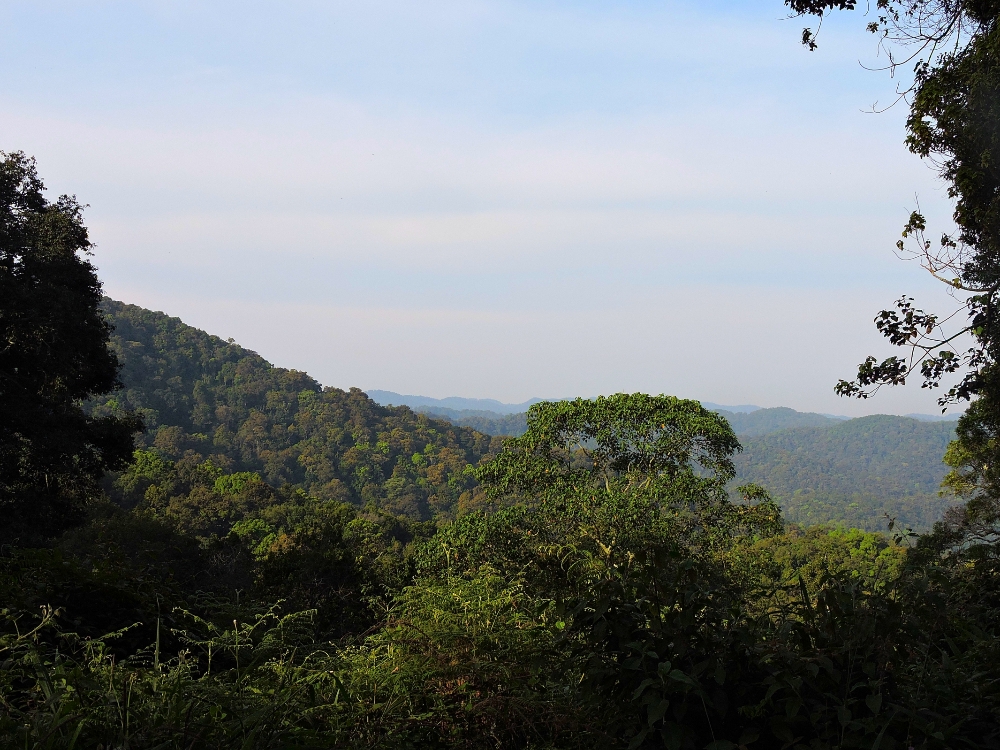
Even before the pandemic, the Gorilla tracking at Bwindi has been closely regulated. A maximum of eight tourists per day, in a single group, can see the Gorillas, with their time around the family strictly limited to one hour. Currently, all humans must wear masks and keep a distance of ten meters away from the Gorillas. Personally, I would have been fine with a longer distance and a shorter time, but those factors were not for me to decide. Additionally, the word Impenetrable
in the name of the park refers to the dense vegetation growing on the forest floor, and that often dictates where humans can stand relative to the family, and that can affect the distance of observation. Gorillas can move easily through the thickets, like a massive ship slicing through the ocean, but humans, not so much. Furthermore, the Gorillas have minds of their own, haven’t heard the rules, and probably wouldn’t care even if they had, so Human-Gorilla social distancing may be somewhat unreliable. However, after seeing the environment where the Gorillas spend their days, it does seem to me that the forest itself will make it difficult for the virus to spread, as long as all the humans remain vigilant.
For what felt like the first time in several months for me, good luck seems to have befallen my Gorilla tracking experience. First of all, Uganda has been offering discounts to their parks and activities, part Holiday Specials,
and part pandemic recovery incentives,
so the price for a tracking permit for the next few months was reduced from seven hundred to four hundred US Dollars (that is fifty Dollars less than what Rwanda was charging fifteen years ago, and a little over a quarter of what it costs there today.) During the daylight hours, rangers monitor the habituated Gorilla families and make a note of where they bed down for the night. The following morning the rangers return to that spot and try to locate where the family has moved to next. I was fortunate that one of the families was found in a reasonably close and accessible location. Best of all, while there had been several tourists on the previous day, and more coming in the days that followed, on that occasion I was the only visitor going that morning, meaning it would only be me, one ranger guide, one porter, and the four or five trackers in the vicinity of the animals on that day.
The family that was located was feeding only about one hundred twenty meters away from the Park road, but that location was down a very steep hill and the Impenetrable vegetation made getting there a very slow, laborious, and slightly risky process. The trackers said that the family had come uphill somewhat during the early morning, and if they had decided to go further down instead, it would have been much more difficult to reach them. Afterwards, I imagined how much more annoying and stressful it would have been had there been a full compliment of eight tourists that day, with everyone trying to stand on the one tiny patch of flat ground that afforded a clear view. We watched the Kyagurilo family group, which has eight members, of which I saw four. I should probably note that my camera has a rather strong lens and some of the photos below may seem to be taken from closer than I was in reality.
This is Bajurizi the baby girl of the group, at an age of three and a half years. She enjoyed sitting at the tops of trees and was the only individual who exhibited the famous Gorilla chest-beating display.
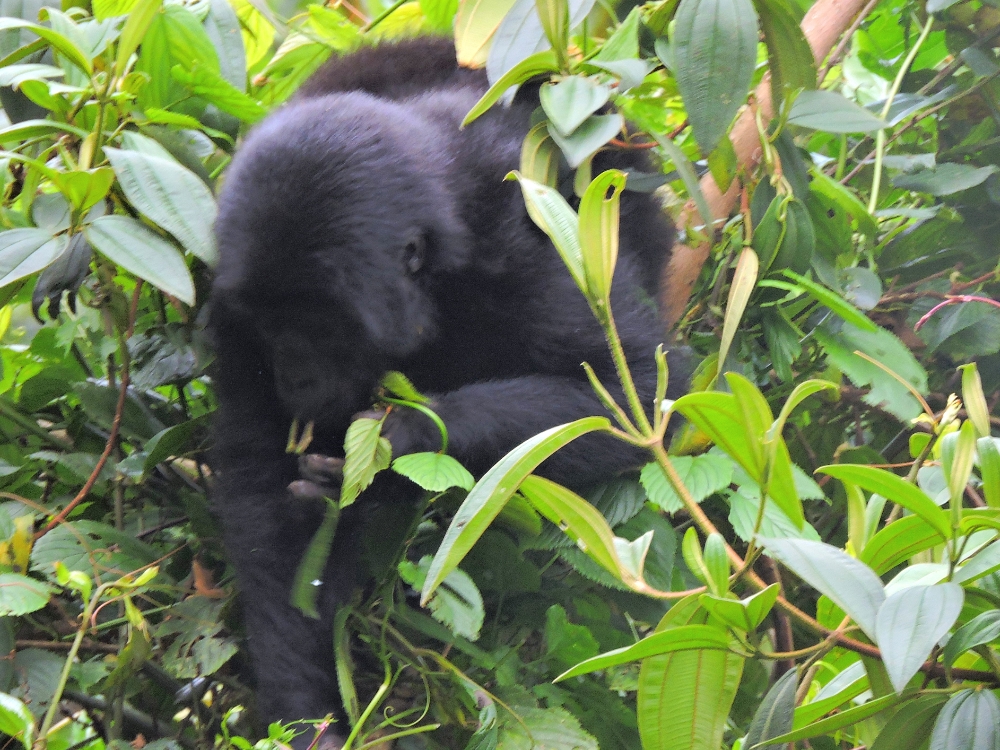
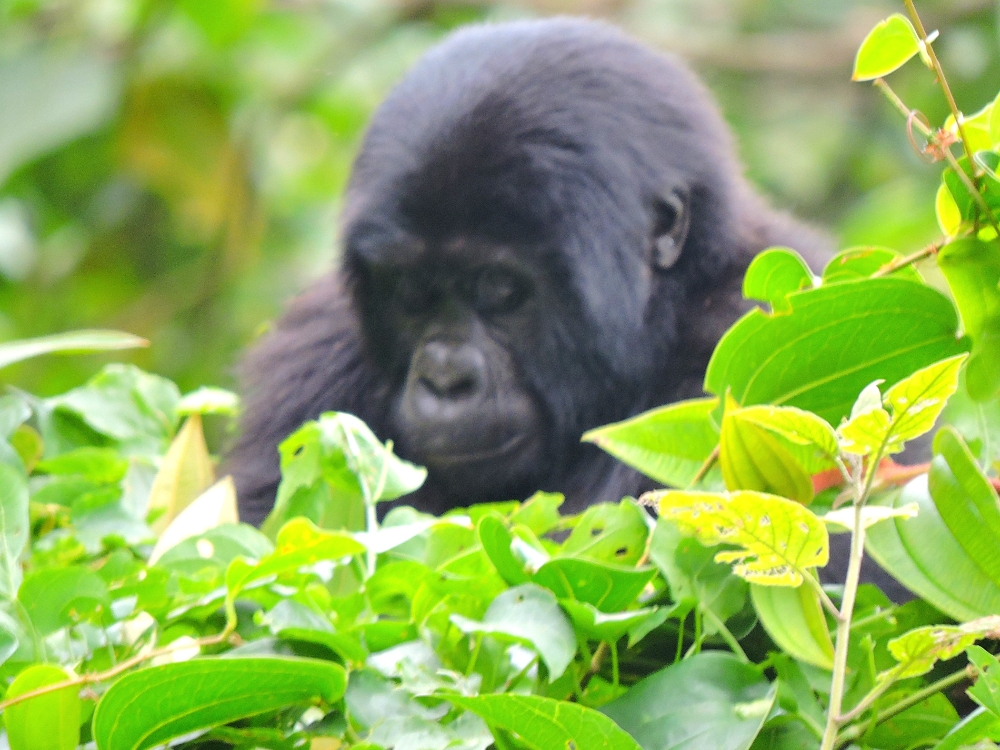
The dark blob in this image is Happy, and this was my only photo of him. He is young adult male Blackback,
who may lead the family one day. He was the only adult that moved through the trees, and once used his weight to bend one in the direction he so desired as a means of moving forward.
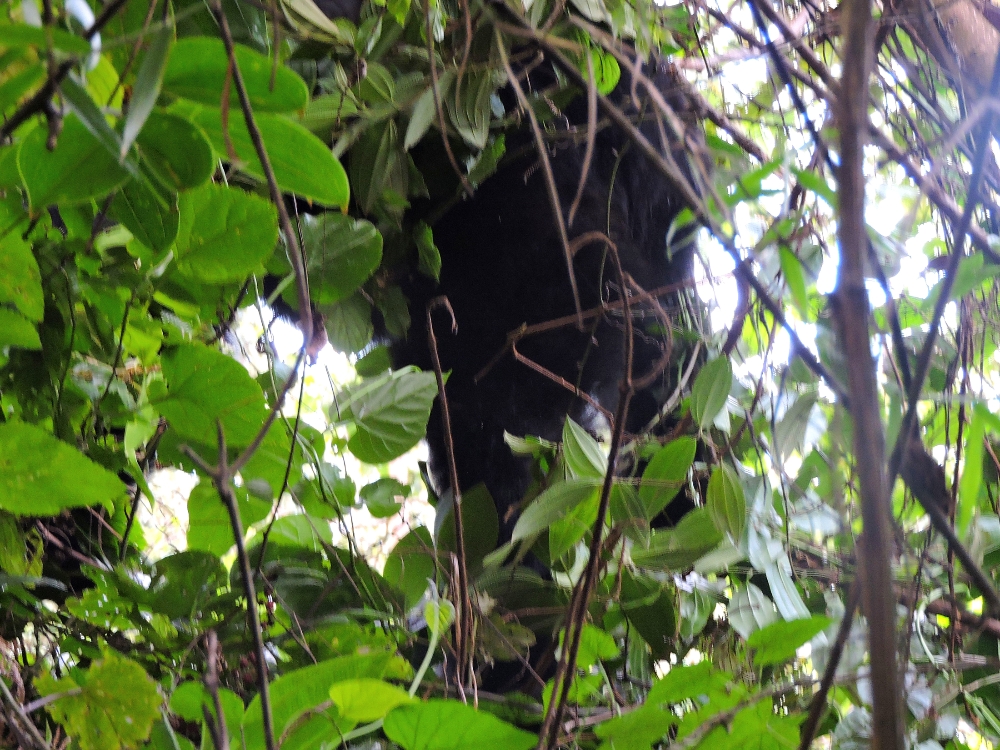
The matriarch of the family is Tindamanyire, whose name means Unknown Origin,
because she was born to another unidentified family. At one point she decided to reposition herself and along the way she flaunted the rules by sitting down only three meters in front of me, at which point all the humans present backed away slowly.
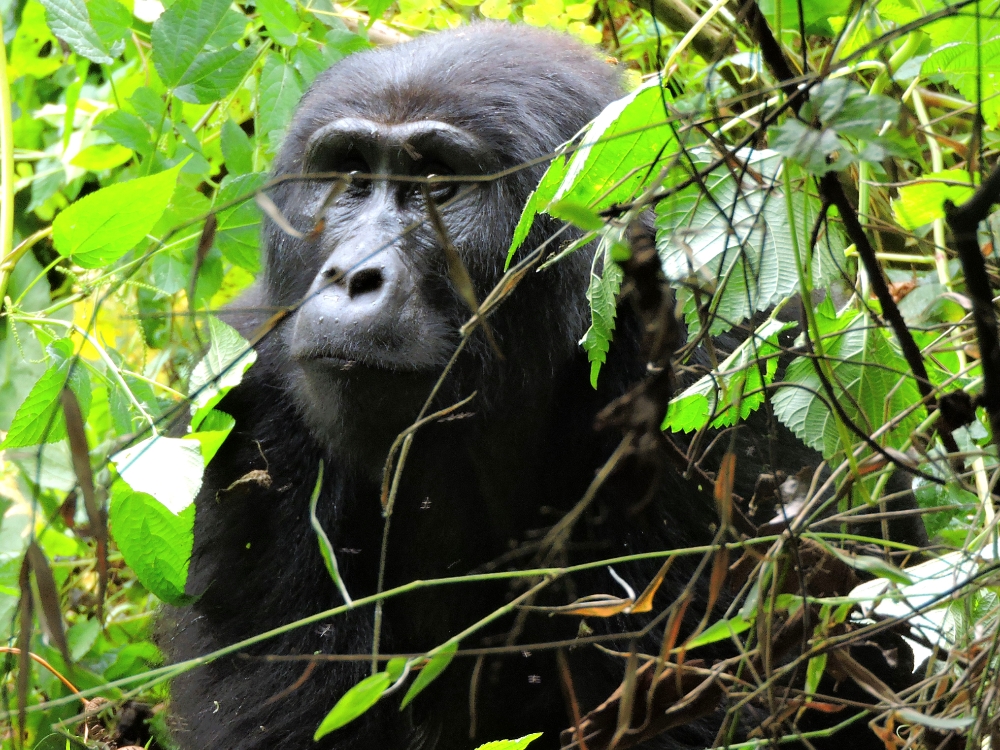
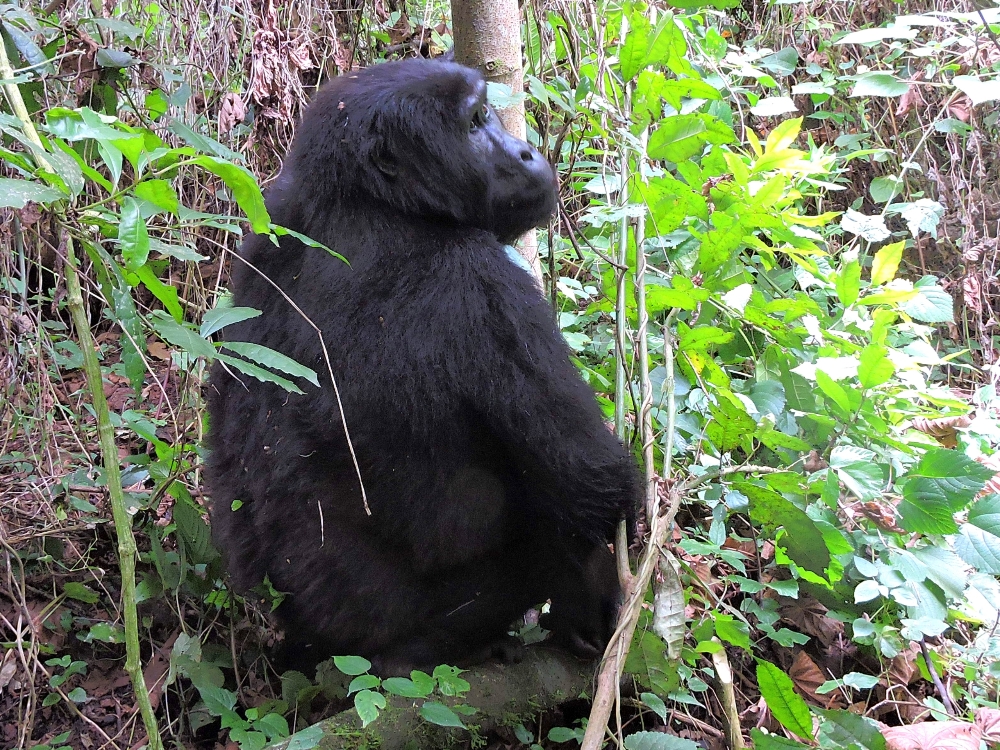
The Silverback of the Kyagurilo family is called Rukara, and like all the Gorillas that day, he seemed to be totally disinterested in the group of humans who came to pay his family a visit, so I watched him for a much longer time than the others. He was enjoying a feast of a tasty herbaceous plant, eating the leaves and the pith of the stems, after stripping the bark off with his teeth. He had found a comfortable place to sit, and spent the hour feeding by consuming everything that was within arm’s reach before presumably moving on at a later time. I have seen a few other members of the animal Kingdom adopt this feeding strategy and, when you think about it, it is not a particularly bad way to live. To me it is clear that Gorillas were inappropriately feared and misunderstood for a very long time. Unmolested, they are naturally docile and unobtrusive herbivores, and it is unfortunate that it took us so long to realize that fact.
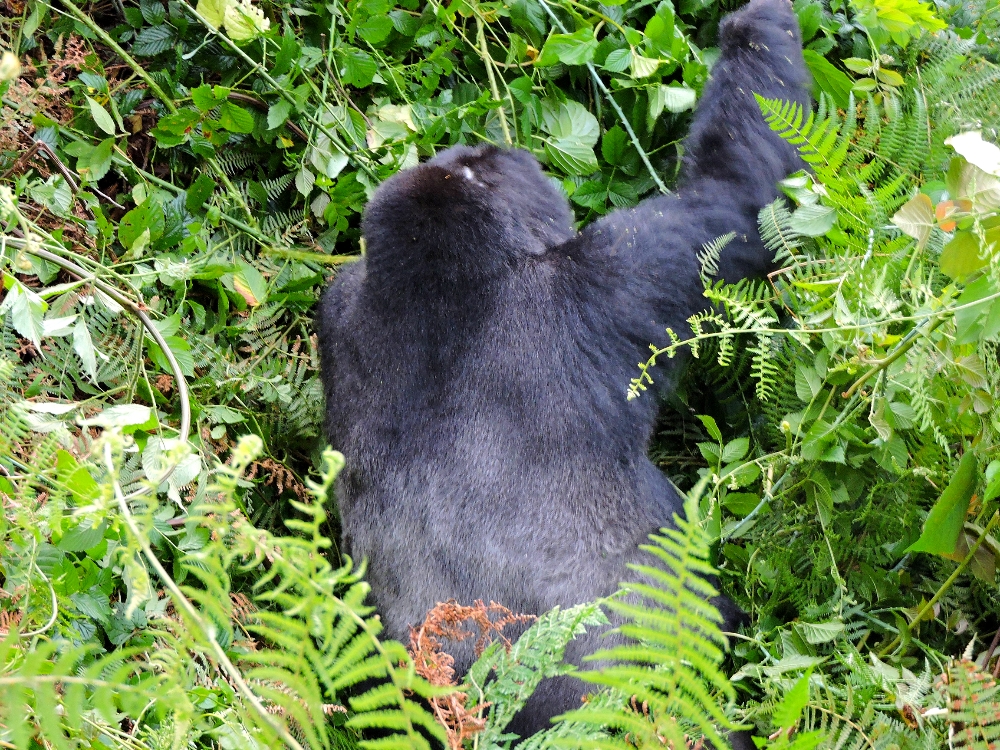
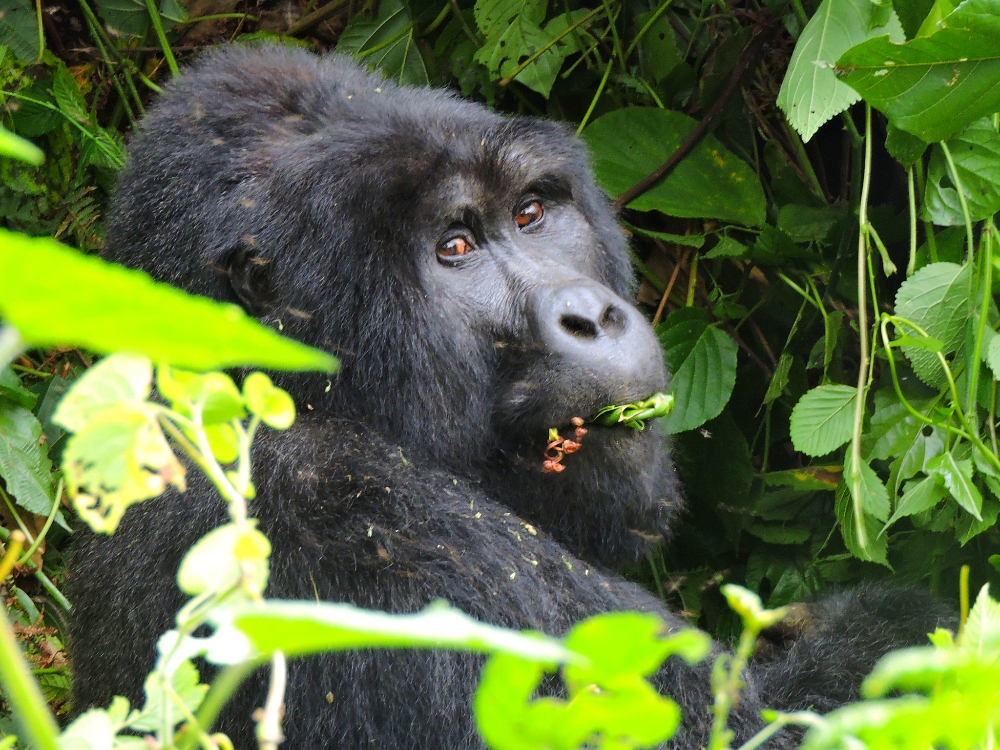
I spent my last two days in Bwindi looking for birds, first around the lodge, then on a long, arduous walk through the mountains to a small parcel of wetland. The trail to the latter location was mostly unimproved, so it turned out to be a very muddy affair. Actually, the trail had been improved,
but that job had been done by elephants, and their definition of improvement is somewhat different than mine. There is a nice selection of birds to be found in Park, including most of the Albertine Rift endemics, but, like most tropical forests, sightings can be challenging. I saw some excellent species, to be sure, but I might have hoped for a slightly larger count, and the number I saw without obtaining a photograph was also higher than I would have liked. However, all things considered, this was a very memorable Site visit, one that was definitely unique in its experience. Most of all, I am certainly happy that I finally was able to correct my earlier blunder.